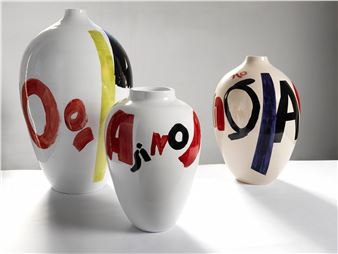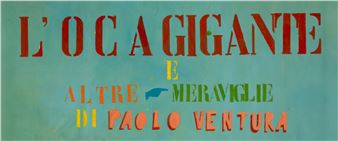Anna Malagrida
A key protagonist on the contemporary Spanish scene, with numerous solo and group shows to her name across Europe and the United States, Anna Malagrida (Barcelona, 1970) is an artist who puts her message across through photography, video and installation.For the exhibition to be held at the Palazzina dei Giardini, the debut show of the Spanish artist in our country, Anna Malagrida will produce three new works, one of which will then be donated to the Contemporary Photography Collection of the Galleria Civica.
The expositional itinerary includes various series of snapshots accompanied by a number of videos, along with a surprising installation entitled "La sala de baile" which will occupy the entire entrance area of the Palazzina: a fabric object, alluding to a 19th-century ball dress, hangs suspended beneath the cupola, reflected by a number of mirrors, as if following a number of dance steps. The installation provides a contemporary reinterpretation of the original purpose of the Palazzina: the Party Hall of the Estense Court.
The exhibition will also include some of her most famous images, such as "Interiores" (2000-2001), a series made up of 16 photographs based around portraits of people close to the artist and the reproduction of the streets and houses of the village of Mouchotte, or "Vistas Veladas" (2007), with images taken during a journey to Jordan, of which the main protagonist is the city of Amman captured from above, from the windows of a number of luxury hotels. A work complementary to this series, also visible in the show, is the video "Danza de Mujer", shot in the Jordanian desert in 2007, which portrays the interior of a shelter, showing a dark veil covering a small window, moving in the wind from time to time, like a dancer. The "dance" of the veil is thus a visual metaphor which refers to the overall condition of women in the Arab world.
The catalogue, published by Tf.Editores, is in English and French (with texts in Italian in an attached brochure). The volume features essays by Rachida Triki, art historian at the University of Tunis, Martin Peran, art critic and professor of art history at the University of Barcelona, texts by Isabel Tejeda, the curator of the exhibition, and an interview with Anna Malagrida herself.
Born in Barcelona in 1970, Anna Malagrida has lived in Paris since 2004. She made her debut as a photographer in 1988, the year in which she enrolled at the Universitat Autònoma de Barcelona, where she went on to graduate in Information Sciences. Her training continued at the École Nationale Supérieure de la Photographie in Arles (1993). After 1998 she began to develop her own personal poetics, poised between opacity and transparency, intimacy and exteriority, everyday life and representation, examining both the physical and conceptual limits of the visible within her images. Her works invite the spectator to try out a double-edged experience: both physical and intuitive at the same time. A form of duality proposed through her recurrent scenarios – the window, the frontier – are exploited to allow for interplay between various spaces and hint at an underlying idea of instability and ambiguity. Anna Malagrida sounds out the relationship between photography and the contemporary world; evident traces emerge in her work of an ongoing reflection on the image in modernity, the limits of photography and the duality of the gaze. The window is a key motif in her poetics, and one to which the artist allots a strategic role: it is the limit between the inside and the outside, the threshold across which she invites the spectator to come into contact with the photographic image. It is an element of separation or a fragment capable of bringing together various threads of reality. At times it is even represented as a mere transparent glass which does not interfere with our perception, while on other occasions it takes on a decidedly more pictorial nature. However, not everything is always visible in Malagrida’s work. The space of the window always implies an unseen area, inviting the onlooker to make use of it to unleash his/her imagination.
A key protagonist on the contemporary Spanish scene, with numerous solo and group shows to her name across Europe and the United States, Anna Malagrida (Barcelona, 1970) is an artist who puts her message across through photography, video and installation.For the exhibition to be held at the Palazzina dei Giardini, the debut show of the Spanish artist in our country, Anna Malagrida will produce three new works, one of which will then be donated to the Contemporary Photography Collection of the Galleria Civica.
The expositional itinerary includes various series of snapshots accompanied by a number of videos, along with a surprising installation entitled "La sala de baile" which will occupy the entire entrance area of the Palazzina: a fabric object, alluding to a 19th-century ball dress, hangs suspended beneath the cupola, reflected by a number of mirrors, as if following a number of dance steps. The installation provides a contemporary reinterpretation of the original purpose of the Palazzina: the Party Hall of the Estense Court.
The exhibition will also include some of her most famous images, such as "Interiores" (2000-2001), a series made up of 16 photographs based around portraits of people close to the artist and the reproduction of the streets and houses of the village of Mouchotte, or "Vistas Veladas" (2007), with images taken during a journey to Jordan, of which the main protagonist is the city of Amman captured from above, from the windows of a number of luxury hotels. A work complementary to this series, also visible in the show, is the video "Danza de Mujer", shot in the Jordanian desert in 2007, which portrays the interior of a shelter, showing a dark veil covering a small window, moving in the wind from time to time, like a dancer. The "dance" of the veil is thus a visual metaphor which refers to the overall condition of women in the Arab world.
The catalogue, published by Tf.Editores, is in English and French (with texts in Italian in an attached brochure). The volume features essays by Rachida Triki, art historian at the University of Tunis, Martin Peran, art critic and professor of art history at the University of Barcelona, texts by Isabel Tejeda, the curator of the exhibition, and an interview with Anna Malagrida herself.
Born in Barcelona in 1970, Anna Malagrida has lived in Paris since 2004. She made her debut as a photographer in 1988, the year in which she enrolled at the Universitat Autònoma de Barcelona, where she went on to graduate in Information Sciences. Her training continued at the École Nationale Supérieure de la Photographie in Arles (1993). After 1998 she began to develop her own personal poetics, poised between opacity and transparency, intimacy and exteriority, everyday life and representation, examining both the physical and conceptual limits of the visible within her images. Her works invite the spectator to try out a double-edged experience: both physical and intuitive at the same time. A form of duality proposed through her recurrent scenarios – the window, the frontier – are exploited to allow for interplay between various spaces and hint at an underlying idea of instability and ambiguity. Anna Malagrida sounds out the relationship between photography and the contemporary world; evident traces emerge in her work of an ongoing reflection on the image in modernity, the limits of photography and the duality of the gaze. The window is a key motif in her poetics, and one to which the artist allots a strategic role: it is the limit between the inside and the outside, the threshold across which she invites the spectator to come into contact with the photographic image. It is an element of separation or a fragment capable of bringing together various threads of reality. At times it is even represented as a mere transparent glass which does not interfere with our perception, while on other occasions it takes on a decidedly more pictorial nature. However, not everything is always visible in Malagrida’s work. The space of the window always implies an unseen area, inviting the onlooker to make use of it to unleash his/her imagination.

 ARTISTS
ARTISTS











